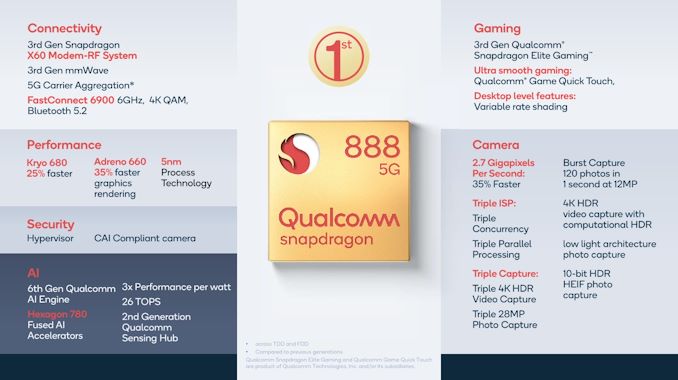Qualcomm Details The Snapdragon 888: 3rd Gen 5G & Cortex-X1 on 5nm
by Andrei Frumusanu on December 2, 2020 10:00 AM EST- Posted in
- Mobile
- Qualcomm
- Smartphones
- SoCs
- 5G
- Cortex A78
- Cortex X1
- Snapdragon 888
Conclusion & First Impressions
The new Snapdragon 888 is overall a very impressive package from Qualcomm, advancing the most important areas for which today’s smartphones are being used. 5G connectivity was the big new feature of 2020 SoCs and smartphones, and the new 888 platform represents the evolution and maturing of the new technologies that had been introduced in prior generations.
The big focus point of the Snapdragon 888 were clearly AI and cameras. The new Hexagon 780 IP block looks immensely impressive and to me seems like a major competitive advantage of the new SoC design – other vendors which aren’t as vertically integrated with their accelerator IPs will have to respond to Qualcomm’s new advancements as it seems like a major performance advantage that will be hard to mimic.
Today’s flagship smartphones have diminished ways of differentiating themselves from one another, with the cameras still being the one aspect where vendors still have very different approaches to their designs. Qualcomm’s push for a triple-ISP system in the Snapdragon 888 pushes the upper limits of what vendors will be able to do on their smartphones, allowing for a continued push for the smartphone camera ecosystem. Even for still-picture camera experiences, it seems that Qualcomm is expecting a more notable technology jump in 2021 as we see the introduction of new sensors and imaging techniques, enabled by the new SoC.
The new CPU configuration gives the new SoC a good uplift in performance, although it’s admittedly less of a jump than I had hoped for this generation of Cortex-X1 designs, and I do think Qualcomm won’t be able to retain the performance crown for this generation of Android-SoCs, with the performance gap against Apple’s SoCs also narrowing less than we had hoped for.
On the GPU side, the new 35% performance uplift is extremely impressive. If Qualcomm is really able to maintain similar power figures this generation, it should allow the Snapdragon 888 to retake the performance crown in mobile, and actually retain it for the majority of 2021.
The new Snapdragon 888 to me looks like a continuation of Qualcomm’s excellent execution over the last few years. Striking a balance between performance, power efficiency, and features is something that may be harder than it sounds, and Qualcomm’s engineering teams here seem to be focused on being able to deliver the overall best package.
Much like the Snapdragon 865, and the last couple of generations of Snapdragon SoCs before it, I expect the new Snapdragon 888 to be an excellent foundation for 2021’s flagship devices, and I’m looking forward to experience the new generation.
Related Reading:
- Qualcomm Tech Summit 2020: Day One LiveBlog (10:00 ET, 15:00 UTC)
- Qualcomm’s New 3rd Generation Snapdragon X60 5G Modem, Built on 5nm
- Qualcomm Announces Snapdragon 865+: Breaking the 3GHz Threshold
- The Snapdragon 865 Performance Preview: Setting the Stage for Flagship Android 2020
- Qualcomm Announces Snapdragon 865 and 765(G): 5G For All in 2020, All The Details
- The Snapdragon 855 Performance Preview: Setting the Stage for Flagship Android 2019
- The Qualcomm Snapdragon 855 Pre-Dive: Going Into Detail on 2019's Flagship Android SoC











123 Comments
View All Comments
AntonErtl - Thursday, December 3, 2020 - link
The 888 has a separate voltage plane for the low-power cores. Having one voltage plane for the big cores looks sensible, too: My guess is: If you have a single-threaded application, you run it on the X1 at max voltage; but if you have a multi-threaded load, doing that and running the A78s at their max voltage consumes too much power, so you reduce the X1 voltage and clock to the 2.42GHz of the A78 to keep the power consumption in check.iphonebestgamephone - Thursday, December 3, 2020 - link
The x1 clock is at 2.84 in sd855 during multo threaded loads.iphonebestgamephone - Thursday, December 3, 2020 - link
Id think even one a78 costs more than 4 a55.Wilco1 - Friday, December 4, 2020 - link
Yes the efficiency results show a low-clocked OoO core would be better overall. Cortex-A78 would be overkill as a little processor - fast CPUs use a lot of area. So a cut-down variant maybe with the micro-op cache removed and limited to 3 or 4-way would make more sense (a bit like Cortex-A76).zamroni - Wednesday, December 2, 2020 - link
And samsung will continue force feeding non usa galaxy s buyer with mediocre exynosArcadeEngineer - Thursday, December 3, 2020 - link
I don't see why Exynos would be any worse than this, it's going to be be the same cores on the same process now.iphonebestgamephone - Thursday, December 3, 2020 - link
Theres the mali gpu.peevee - Wednesday, December 2, 2020 - link
"This year’s choice of switching back to a Samsung process for the flagship SoC seems to be a vote of confidence in the new process node- as otherwise Qualcomm likely wouldn’t have made the switch"Such decisions are made for monetary reasons and monetary reasons only. Samsung 5nm is not as good as TSMC 5nm.
zodiacfml - Wednesday, December 2, 2020 - link
Why a huge single core? Impressive ISP, still baffling traditional camera makers can't make a camera from smartphone parts. Current mobile camera sensors, it is already on par with APSC cameras with a zoom kit lens.techconc - Thursday, December 3, 2020 - link
Why a huge single core? Single core performance is pretty much what matters most because ALL applications can benefit form this. Also, lots of web apps (Javascript based) are single threaded by nature. That's why iPhones just crush Android phones on all of the javascript / web benchmarks.